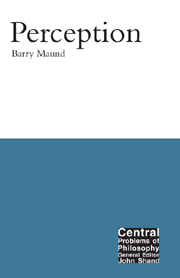Book contents
- Frontmatter
- Contents
- Preface
- 1 The philosophy of perception
- 2 A theory of natural realism
- 3 Theories of perceptual experiences
- 4 Representationalism: representations as natural signs
- 5 Natural realism: Putnam, Austin and Heidegger
- 6 Perception: the argument from illusion
- 7 The phenomenal and phenomenological senses of “looks”
- 8 Types of perceptual content
- 9 The representationalist–intentionalist thesis
- 10 Adverbialist accounts of perceptual experience
- Conclusion
- Notes
- References
- Index
4 - Representationalism: representations as natural signs
- Frontmatter
- Contents
- Preface
- 1 The philosophy of perception
- 2 A theory of natural realism
- 3 Theories of perceptual experiences
- 4 Representationalism: representations as natural signs
- 5 Natural realism: Putnam, Austin and Heidegger
- 6 Perception: the argument from illusion
- 7 The phenomenal and phenomenological senses of “looks”
- 8 Types of perceptual content
- 9 The representationalist–intentionalist thesis
- 10 Adverbialist accounts of perceptual experience
- Conclusion
- Notes
- References
- Index
Summary
We can, I have argued, identify primary cases of perception as ones that involve the acquiring of knowledge, both practical and theoretical. Both kinds of knowledge are what might be called “object-based knowledge” and involve knowledge by acquaintance. The practical knowledge is manifested in a variety of ways: in locating the object in space, discriminating the object from its background and in targeting one's action on the object, for example, in grasping, touching or pushing the object in question.
The description of object-based knowledge in this context suggests that the right theory of perception is some version of direct realism, and that indirect, representative theories are ruled out. This suggestion, I shall argue, ought to be resisted. It is possible, however, to formulate a representative theory of perception that will handle this kind of perceptual knowledge, a hybrid theory, to be more accurate, that contains direct and indirect components.
Direct and indirect theories of perception
One of the central questions in the philosophy of perception is whether perception is direct or indirect. This question historically has been framed within the context of the debate between direct realist theories of perception, and the representative theory of perception (representational realism), where the latter is understood as committed to indirect realism. The contrast is typically registered in the following way:
Indirect realism/representational realism: The perceiver perceives physical objects and states of affairs indirectly by perceiving immediately or directly other items, standardly sensory particulars or states of affairs.
Direct realism: The perceiver perceives immediately (or directly) physical objects and states of affairs without perceiving any intermediary.
- Type
- Chapter
- Information
- Perception , pp. 67 - 88Publisher: Acumen PublishingPrint publication year: 2002

